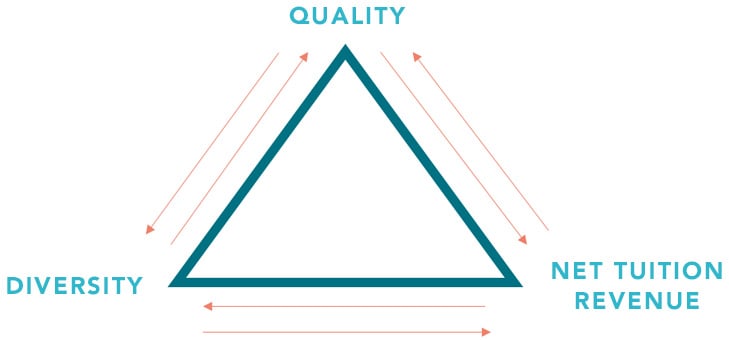Best Practices: How to Manage Enrollment Goals in Five Steps

Chris Lucier
Why do you need to have a standardized process to create enrollment goals?
During my 12-year tenure as a chief enrollment officer, I experienced this situation time and time again --The President wants to increase diversity, net tuition revenue (NTR), and quality. The Provost wants to increase diversity and quality and bring in more students. The CFO wants to increase NTR after financial aid, and you, the Enrollment Officer, must determine how to put it all together in today’s dynamic and competitive enrollment market.
Given the current undergraduate enrollment environment, there cannot be wasted efforts. Budgets are not unlimited, and goals are often competing. Wasted efforts and lack of clear goals lead to many frustrations. Often those frustrations are transparent to prospective students and parents and could impact a student’s decision to attend or not to attend your institution.
By having a standardized process to create enrollment goals, you can promote operational effectiveness and efficiency among all members of the enrollment team and other campus partners. With a process and set goals, you can ensure clarity among senior leadership and make sure all are aware of the costs and trade-offs.
The Iron Triangle

The Iron Triangle recognizes that there are trade-offs and costs associated with the different goals. If you lift one side of the triangle, then other two must contract. For example, if you want to increase quality and keep NTR consistent, then diversity will decline. If you want to increase NTR, then you may end up with less diversity or quality.
When you are meeting with your leadership, share the Iron Triangle. It’s a great visual because it highlights the costs and trade-off as you’re defining goals.
Five Steps to Managing Enrollment Goals
These are the steps that I used to create enrollment goals.
I. Align Enrollment Goals with Budget
To align the enrollment plan with the institutional assumption of net tuition revenue, you need a few pieces of information, including:
- New student (first time freshmen and external transfer) headcount and/or net tuition revenue assumptions for the next fiscal year
- Forecasted UG enrollment for the current fiscal year
- Long-term new student headcount or tuition revenue assumptions
I recommend scheduling two meetings with senior leadership to get some clarity on where you are going. I invited the President, Provost, CRO, and Budget Officer to my initial meeting. Include who you think needs to be in the room—but don’t let the group get too big.
II. Analyze and Forecast Fall Results
As a next step, analyze forecasted fall new student enrollment against goals (# of students, NTR, quality, diversity, academic programs, special programs, etc.). Depending on your institution, you may have started to analyze and forecast in May. Look at where you met your goals, where you exceeded and where you fell short.
What worked? Where did your efforts fall short?
I can’t emphasize enough that data is key in this step. You can no longer look at things at the macro level. You need to drilldown to specific populations and find out what’s going on there. For example, when I was at Delaware, we noticed a decline in deposits from New York. The easy assumption was that NY state’s Excelsior Scholarship was reducing yield from New York. By examining our data, we figured out that it wasn’t the Excelsior Scholarship, but that it was other factors affecting the yield of that segment.
III. Develop Scenarios… with costs!
In this step, you can develop cost estimates for the class the following fiscal year and over four years. These scenarios will help you anticipate questions and develop supporting materials for your meetings (See Step 4). I developed four scenarios:
- Display forecasted NTR, quality, and diversity if you do the same things you did the past admissions year
- Display NTR if you manage your admissions and financial aid process to achieve a significant improvement in quality, while holding diversity essentially the same
- Display NTR if you manage your admissions and financial aid process to achieve a significant improvement in diversity, while holding quality essentially the same
- Display NTR if you manage your admissions and financial aid process to achieve a significant improvement in quality and in diversity
It is very important in this step to assess both the short-term and long-term costs associated with the different scenarios. For example, the president wanted to increase diversity and quality and we forecasted we would need $6 million more in financial aid for the next fiscal year (in other words, $6M less in NTR). However, when we extended that freshmen enrollment out three more years, the forecasted increase in financial aid over all four years was $21 M; a significant impact on NTR. Developing multiple scenarios based off your understanding or anticipation of the goals of your senior leaders will ensure you present a clear picture of trade-offs and long-term impacts.
IV. Present Initial Scenarios (Meeting #1)
Meet with senior leaders to present scenarios, costs, and tradeoffs. The goal with this step is to get guidance from senior leaders so you can refine your scenarios and your current year marketing and recruitment plan. In your presentation, you can share your forecasts of the upcoming new student enrollment against goals and present scenarios with forecasts and costs. I recommend adding a few slides to educate leadership about current and future market trends. Some great sources to pull trend data include using WICHE Knocking at the College Door (state, regional, national), The Chronicle Higher Edu or Inside Higher Education articles related to domestic & international enrollment, NACUBO forecasts, and Bond-rating agency higher education forecasts (Moody’s and Standard & Poor’s).
To prepare for my initial scenario meeting, I’d use Othot’s prescriptive analytics, or What-if scenarios. The What-if scenarios and dashboards will provide senior leaders a visualization of the costs and trade-offs of the different goals. So, if the goal was to increase quality, then I’d show the appropriate What-if to reveal the impacts and the costs on the overall enrollment target.
V. Present Revised Scenarios (Meeting #2)
Set up another meeting to present revised scenarios and receive a decision from senior leadership. In this second meeting, your goal is to get consensus on your enrollment goals. Once you have that consensus, you can communicate your goals to your team and on-campus partners, like the registrar, housing, parking, orientation, deans, etc.
Goals Can Change
While this process has helped to make managing enrollment goals more efficient, there were times when the goals needed to change or there was a low probability of meeting a goal. The reality is that the enrollment environment is dynamic and sometimes, midway through the year, something would change. I can give an example – there was a goal to increase of NTR largely based on increasing new student enrollment of international students. Due to actions at the Federal government level relating to immigration, there was a sharp drop off in demand from international students, particularly students from China. We recognized this early on – in January or February and I knew we had to pivot and enroll more domestic out-of-state students in order to meet the NTR goal. This was a change that had to be made because of market dynamics, not because of the goal setting process. Knowing the long- and short-term goals of the president, enabled us to make changes and inform leadership about the steps we had to take because of market conditions.
When you are in a situation where you may not meet a goal, you may need to run some different scenarios to determine what you can do to change course. Perhaps you can’t meet your enrollment target with the current financial aid budget or there is a resource deficit with staff or communication. This is where a What-if scenario would be so helpful. You can graphically show, based on the expenditure, the trade-off; this is the size of class we can bring in or bring in a class of lower quality or less diversity. If it is a staff or communication resource issue, then that may be increasing the risk that you won’t hit the target. Hopefully you have data showing that you are losing out more to school X or Y. Then you can give examples of your competition’s website or publications to show what is going on the market and assess where you need to make an investment.
This process was enormously helpful to me to set enrollment goals each year. It’s a framework that I followed to create efficiency around a process that was complex and required buy-in from many different stakeholders. Every institution is different, and you can adopt these steps or create your own process. Let me know how it goes – I'd love to hear what’s working for you.

Chris Lucier



